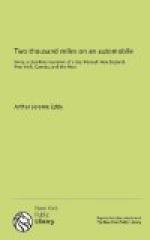When about half-way to Batavia the spark began to show blue; the reserve set of dry batteries was put in use, but it gave no better results. Apparently there was either a short circuit, or the batteries were used up; the bad showing of the reserve set puzzled us; every connection was examined and tightened. The wiring of the carriage was so exposed to the weather that it was found completely saturated in places with oil and covered with mud. The rubber insulation had been badly disintegrated wherever oil had dropped on it. The wires were cleaned as thoroughly as possible and separated wherever the insulation seemed poor. The loss of current was probably at the sparking coil; the mud had so covered the end where the binding parts project as to practically join them by a wet connection. Cleaning this off and protecting the binding parts with insulating tape we managed to get on, the spark being by no means strong, and the reserve battery for some reason weak.
If we had had a small buzzer, such as is sold for a song at every electrical store, to say nothing of a pocket voltmeter, we would have discovered in a moment that the reserve battery contained one dead cell, the resistance of which made the other cells useless. At Batavia we tested them out with an ordinary electric bell, discovering at once the dead cell.
After both batteries are so exhausted that the spark is weak, the current from both sets can be turned on at the same time in two ways; by linking the cells in multiples,—that is, side by side, or in series,—tandem.
The current from cells in multiples is increased in volume but not in force, and gives a fat spark; the current from cells in series is doubled in force and gives a long blue hot spark. Both sparks, if the cells are fresh, will burn the points, though giving much better explosions.
As the batteries weaken, first connect them in multiples, then, as they weaken still more, in series.
Always carry a roll of insulating tape, or on a pinch bicycle tire-tape will do very well. Wrap carefully every joint, and the binding-posts of the cells for the tape will hold as against vibration when the little binding-screws will not. In short, use the tape freely to insulate, protect, and support the wires and all connections.
If the machine is wired with light and poorly insulated wire, it is but a question of time when the wiring must be done over again.
When we pulled up in Batavia at an electrician’s for repairs, the Professor was a sight—and also tired. The good man had floundered about in the mud until he was picturesquely covered. At the outset he was disposed to take all difficulties philosophically.
“I should regret exceedingly,” he remarked at our first involuntary stop, “to return from this altogether extraordinary trip without seeing the automobile under adverse conditions. Our experiences in the sand were no fault of the machine; the responsibility rested with us for placing it in a predicament from which it could not extricate itself, and if, in the heat of the moment and the sand, I said anything derogatory to the faithful machine, I express my regrets. Now, it seems, I shall have the pleasure of observing some of the eccentricities of the horseless carriage. What seems to be the matter?” and the Professor peered vaguely underneath.




